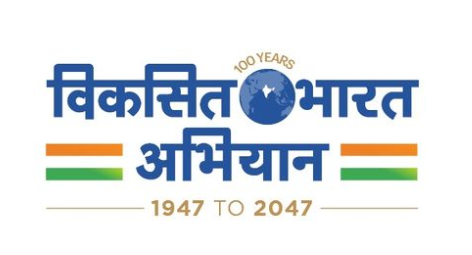Viksit must be Inclusive (GS Paper 3, Economy)

Introduction:
- As temperature is rising atmospherically, It is now confirmed that the year 2023 was the warmest year on record since 1850, according to the National Oceanic and Atmospheric Administration (NOAA).
- The 2023 temperatures were 1.18°C higher than the pre-industrial levels, and many scientists are predicting that 2024 could be even worse.
- Against this backdrop of rising temperatures, the most impotant question for India is: Will Indian agriculture be able to feed our growing population in the medium to long run, and will our farmers also be prosperous in Viksit Bharat@2047.
Early projection of year 2047:
- Although 2047 is still 23 years away, and it is very difficult to make such long-term projections, a rough idea of this can be obtained by looking at what happened since reforms began in 1991 and continued, in one way or the other, under various governments.
- But more interesting would be to see the growth story in the last 10 years under the Modi government and compare it with the preceding 10 years of the Manmohan Singh government.
- Given that the incumbent government feels very confident to come back with a thumping majority, it is likely to continue its policies of the past 10 years, or may even accelerate them to realise its aspiration of Viksit Bharat@2047.
Growth of agri-GDP and overall GDP:
- The accompanying graphic shows the average annual growth rates (AAGRs) of overall GDP and agri-GDP (2011-12 base, revised series).
- While the long-term growth rate from 1991-92 to 2023-24 (second advance estimate) of overall GDP is 6.1%, for agri-GDP it is 3.3%.
- However, during the 10 years of the Modi government, overall GDP has grown only by 5.9% (compared to 6.8% during Singh’s period) and agriculture growth has been 3.6% (compared to 3.5% during Singh’s tenure).
- There is not much of a difference between the two governments with respect to agri-GDP growth.

Importance of agriculture growth in Viksit Bharat Deam
- Agriculture is critical for India’s development as it still engages about 45.8% of working population (2022-23, PLFS data). So, if Viksit Bharat has to be inclusive Bharat, it must develop agriculture to its full potential.
- The productivity needs to rise, water consumption needs to reduce, groundwater needs to be recharged, soil degradation needs to be arrested, and greenhouse gas (GHG) emissions from agriculture need to be curtailed.
- Business as usual, with the current set of policies, is not likely to deliver this dream of inclusive Viksit Bharat by 2047.
- Agriculture contributes roughly 18% to overall GDP but engages 45.8% of the workforce. If growth rates of overall GDP and agri-GDP keep rising as they have during the last 20 years, or even the last 10 years, it is likely that by 2047, agriculture’s share in overall GDP may drop to just 7-8% but it may still be saddled with more than 30% of the workforce.
- More people need to move out of agriculture to higher productivity jobs with better skills.
- Therefore, skill formation of rural people for a rapidly growing and urbanising India has to be a priority.
- Otherwise, Viksit Bharat will be viksit only for the top 25% of the population, while the rest may remain stuck in the low-medium income category.
Future of agri growth
- The expected overall GDP growth of 7.6% in 2023-24 is a good foundation to build on.
- Both the ministry of finance and the RBI feel upbeat, and expect the final numbers of this year to even be higher.
- But agri-GDP growth rate of 2023-24 is a pitiably low level of just 0.7% (second advance estimate.
- Agriculture growth dropped to this low level (0.7%) primarily because of unseasonal rains during the last kharif season. And there are no positive signals that the situation will improve.
- If there are any signals, the risks of extreme weather events are going to increase, as humanity is falling far behind in controlling global warming.
- India in general, and agriculture in particular, is not ready for this climate change.
Successive Failure of agriculture will hinder India's growth rate:
- Indian agriculture in Viksit Bharat cannot be on a weak and risky wicket.
- Two years of successive droughts can spoil the party of Viksit Bharat.
- Even without a drought, the RBI has been fighting almost this entire year to control food inflation.
- The Centre has put export controls, stocking limits on traders, suspended futures trading in many agri-commodities, and unloaded wheat and rice at prices below their economic costs.
- These are all signs of panic, and policy tools of 1960s, when India was living from ‘ship to mouth’.
- This policy toolbox cannot be carried on in Viksit Bharat.
Which policy will be suitable for agriculture for Viksit Bharat?
- Rationalisation of food and fertiliser subsidies, and use of the savings to augment agri-R&D, agri-innovation and agri-extension, recharge soil and water through check dams and watersheds, and promote water saving techniques in agriculture (drip and sprinklers, fertigation, protected cultivation, etc.).
- More importantly, India must move to high-value agriculture (poultry, fishery, dairy, fruits and vegetables) with a value chain approach, from plate to plough—a demand-driven system.
- Policies and institutions through which farmers can access pan-India markets, and even export markets on a regular basis, be it through cooperatives or farmer producer organisation (FPOs) on digital commerce platforms (like eNAM or ONDC) or though contract farming with large processors, retailers, and exporters.
- Promotion of futures trading in agriculture.
Conclusion:
With agriculture on high risk, the government needs to think of policies and institutions to enable farmers to access domestic and global markets.



